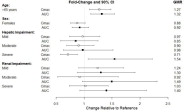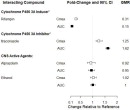Zuranolone
Molecular mass: 409.574 g/mol PubChem compound: 86294073
Mechanism of action
The mechanism of action of zuranolone in the treatment of postpartum depression is not fully understood, but is thought to be related to its positive allosteric modulation of GABAA receptors.
Pharmacodynamic properties
Cardiac Electrophysiology
At two times the maximum recommended dose, zuranolone does not cause clinically significant QTc interval prolongation.
Psychomotor Performance with Alcohol or Alprazolam
Co-administration of repeated 50 mg daily doses of zuranolone with alcohol or alprazolam led to impairment in psychomotor performance.
Pharmacokinetic properties
Zuranolone exposure (Cmax and AUC) increased approximately dose proportionally with doses ranging from 30 mg to 60 mg (1.2 times of the recommended dosage of zuranolone) with a moderate-fat meal (700 calories; 30% fat). Once-daily administration of zuranolone resulted in accumulation of approximately 1.5-fold in systemic exposures and steady state was achieved in 3 to 5 days.
Absorption
Following oral administration, peak zuranolone concentrations occur at 5 to 6 hours (Tmax).
The absolute bioavailability of zuranolone was not evaluated.
Effect of Food
Following administration of 30 mg of zuranolone to healthy subjects, the Cmax increased by approximately 3.5-fold and the AUClast increased by approximately 1.8-fold with a low-fat meal (400 to 500 calories, 25% fat) compared to fasted conditions. The Cmax increased by approximately 4.3-fold and the AUClast increased by approximately 2-fold with a high-fat meal (800 to 1,000 calories, 50% fat) compared to fasted conditions. The Tmax was not impacted by food.
Distribution
The volume of distribution of zuranolone following oral administration is greater than 500 L. The mean blood-to-plasma concentration ratio ranged from 0.54 to 0.58. Plasma protein binding is greater than 99.5%.
Elimination
The terminal half-life of zuranolone is approximately 19.7 to 24.6 hours in an adult population. The mean apparent clearance (CL/F) of zuranolone is 33 L/h.
Metabolism
Zuranolone undergoes extensive metabolism, with CYP3A4 identified as a primary enzyme involved. There were no circulating human metabolites greater than 10% of total drug-related materials and none are considered to contribute to the therapeutic effects of zuranolone.
Excretion
Following oral administration of radiolabeled zuranolone, 45% of the dose was recovered in urine as metabolites with negligible unchanged zuranolone and 41% in feces as metabolites with less than 2% as unchanged zuranolone.
Specific Populations
Racial Groups
Black or African American participants had a 14% higher CL/F compared to participants of other races (Asian, White, or other).
Male and Female Patients, Patients with Renal Impairment, Patients with Hepatic Impairment
Exposures of zuranolone in specific populations are summarized in Figure 1.
Figure 1. Effect of Specific Populations on the Pharmacokinetics of Zuranolone:
Data shown for participants ≥65 years relative to younger participants (18 to 45 years); female participants relative to male participants; renal and hepatic impairment relative to participants with normal renal and hepatic function, respectively. Hepatic impairment: Mild (Child-Pugh Class A); moderate (Child-Pugh Class B); severe (Child-Pugh Class C). Renal impairment: Mild (eGFR 60-89 mL/min/1.73m²); moderate (eGFR 30-59 mL/min/1.73m²); severe (eGFR <30 mL/min/1.73m² and not on dialysis).
CI = confidence interval; GMR = geometric mean ratio
Drug Interaction Studies
The effect of co-administered drugs on the pharmacokinetics of zuranolone is summarized in Figure 2.
Figure 2. Effect of Co-Administered Drugs on the Pharmacokinetics of Zuranolone:
Data shown are zuranolone plus co-administered drug relative to zuranolone alone. CI = confidence interval; GMR = geometric mean ratio; *clinically significant drug interaction
Zuranolone did not affect the pharmacokinetics of alprazolam or ethanol. Increased impairment of psychomotor performance was observed when zuranolone was co-administered with alprazolam or ethanol.
In Vitro Studies
Enzyme systems: Zuranolone is not an inhibitor of CYP1A2, 2B6, 2C19, 2C8, 2C9, 2D6 or 3A4. Zuranolone is not an inducer for CYP1A2, CYP2B6 or CYP3A4 at the therapeutic dose range.
Transporter systems: Zuranolone is not a substrate of P-glycoprotein (P-gp), BCRP, OATP1B1 or OATP1B3. Zuranolone does not inhibit P-gp, BCRP, BSEP, OATP1B1, OATP1B3, OAT1, OAT2, OCT1, OCT2, MATE1, or MATE2.
Related medicines
© All content on this website, including data entry, data processing, decision support tools, "RxReasoner" logo and graphics, is the intellectual property of RxReasoner and is protected by copyright laws. Unauthorized reproduction or distribution of any part of this content without explicit written permission from RxReasoner is strictly prohibited. Any third-party content used on this site is acknowledged and utilized under fair use principles.

